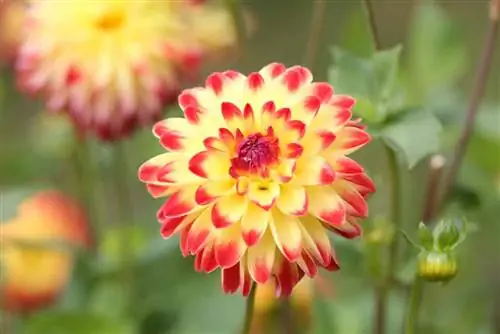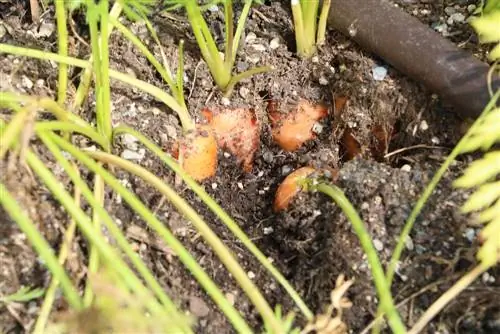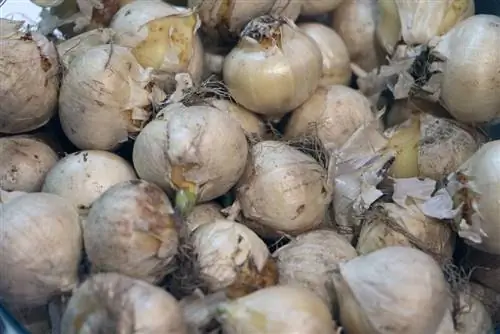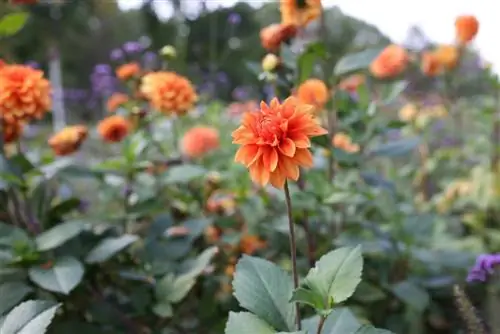- Author admin [email protected].
- Public 2023-12-17 03:39.
- Last modified 2025-01-24 12:45.
All summer long, the dahlia flowers bring joy to many hobby gardeners in their own garden. Dahlias are subtropical flowers native to Mexico and other Central American countries. The secret to successfully cultivating plants with eye-catching flowers lies underground: in the dahlia tubers. When the first frosts arrive, it's time to relocate. You can find out everything you need to consider in this article.
Winter hardiness
Dahlias, botanically Dahlia, are perennial, herbaceous plants that form tubers in the soil in order to survive. During the growth period, especially at the end of the flowering period, the dahlia stores various nutrients in these tubers so that it can sprout again in the spring. Since dahlias are originally used to warm temperatures, they are unfortunately not sufficiently hardy in our area. If you want a lush abundance of flowers the following year, you should overwinter your plants properly.
Wintering options
Since the dahlia is not winter hardy, the underground tubers must be protected from frost. There are different options for this:
- Dig up tubers and store them in the cellar
- Leave tubers in the pot
- Protect tubers outside from frost
The fewest losses will occur if you remove the dahlia tubers from the garden bed or planter in autumn and store them in a dry place. All other methods do not reliably protect the tubers.
Overwintering in a pot
If you want to overwinter your dahlias in a plant pot, cut all shoots down to about 10 cm above ground level after the first frosts and dispose of the cuttings in organic waste or compost. The pots are then placed in a cool, frost-free place where it should be dark. If the temperatures rise above 10 degrees, the dahlia begins to sprout again. Keep the soil dry during the winter break to prevent mold and rot. So under no circumstances water or spray.
Tip:
Provide the tubers with fresh soil and a little fertilizer in spring, then they can be put out into the fresh air again after the Ice Saints.
Wintering outdoors
Some gardeners also overwinter their plants outdoors. However, there is a great risk that the tubers will not survive the cold temperatures.
- cut off dried shoots
- at 5 to 10 cm above ground level
- Pile up a thick layer of leaves or straw
- additionally cover with polytunnel or bubble wrap
- the tubers must not get wet
- Weigh down the foil with a few stones
- remove the winter cover again in spring
- from temperatures of 10 degrees
Tip:
Overwintering outdoors in wine-growing areas or when the dahlias are planted close to the house is best.
Time
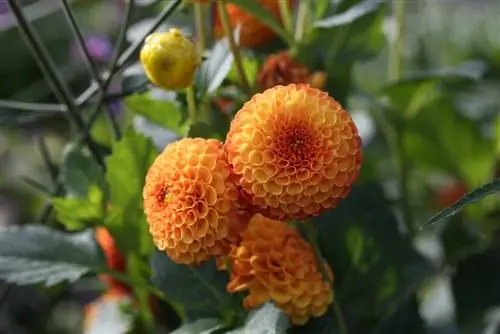
The timing of when to remove dahlias from the garden soil may be a bit tricky for beginners. Because the tubers must not be taken out of the ground too early. Towards the end of the vegetation phase, the plant stores nutrients in these tubers for the following year. If the stems are still green, the saving process is not yet complete. If the dahlia is dug up too early, it may be too weak to sprout again next spring. The coveted flowering plant shouldn't stay outside for too long, because it dies when the ground freezes severely. As soon as the first frosts set in in autumn, the dahlias must be removed from the garden soil. The ideal time has come when the shoots on the plants above ground level have frozen and are now brown and hanging down unsightly. A few light frosts will not harm the plant.
Preparation
In preparation for winter rest, the perennials are only watered sparingly from the end of August. Reducing moisture causes the dahlia to increase its efforts to store reserves in the underground tubers. When the first night frosts set in, the foliage begins to wilt and the above-ground parts of the plant die.
Unearth
When you dig up the dahlias, the garden soil should be as dry as possible, because in this case the soil separates more easily from the roots and tubers. The best way to dig up the dahlias is with a digging fork. This means there is little risk of unduly injuring the tubers and roots. Before digging, cut the shoots back to about five to ten centimeters above the root base. A stem remnant of at least five centimeters long must remain on each of the storage organs, because the dahlia will sprout again from this so-called root neck next spring. Gently knock off any remaining soil from the tuber.
Labeling
An important detail that is often forgotten is to mark the dahlia with a label indicating what variety and flower color it is. You should do this step immediately after digging, otherwise next spring you will probably no longer know which tuber belongs to which variety. This turns the flower bed into a colorful mess because you can no longer tell the individual varieties apart.
Cleaning
Wash stuck-on dirt from your dahlia tubers by swirling them in a bowl or tub of room temperature water. Be very careful during this procedure, as even minor injuries to the skin can lead to the entry of germs, causing the tubers to rot in their winter quarters.
Prevent infections
Before the dahlia tubers are stored, they should be subjected to a thorough inspection. Damaged areas begin to rot easily and cause the rot and mold pathogens to spread further. Damaged tubers can often still be saved.
- cut out rotten areas generously with a sterile knife
- remove dead parts
- Separate the mother tuber
- this first year tuber tends to rot
- Disinfect interfaces with charcoal powder
- alternatively use sulfur powder
- sort out and compost all damaged tubers
- only store he althy, strong dahlia tubers
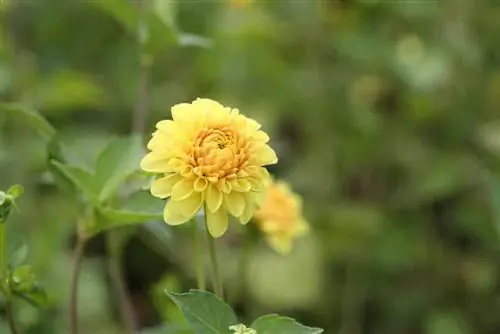
Charcoal can be found in almost every household. If you use charcoal for grilling, you can simply collect the charcoal powder that always ends up at the bottom of the packaging. The charcoal powder usually ends up in the trash can, but it can also be used to care for plants. Always store damaged or infected tubers separately so that the pathogens do not spread to the he althy storage organs. Severely infected tubers should be sorted out immediately and disposed of in the compost.
Division
Older, well-established dahlias produce thick, numerous storage organs. Before storage, it is possible to divide the tubers to rejuvenate and propagate the plant. Ideally, each section has at least one eye. If you're not sure, you can wait until spring. Typically, these eyes grow during the dormant period, making them more noticeable in early spring.
Cutting roots
The small roots that grow from the sides of the tubers have no further function. They usually die back over the winter. Therefore, they can be cut off immediately before storage to avoid the possibility of infection.
Drying
Before storing the tubers, it is best to let them dry for a few weeks in a warm and well-ventilated place. If the tubers and roots are still wet when they are stored, the risk that they will begin to rot increases. If the temperatures outside are still well above freezing during this period and the weather is dry, the dahlia tubers can simply be dried outdoors on newspaper. Good air circulation is important so that the storage organs can dry well. However, choose a place where the storage organs are not exposed to direct sunlight. The goal is to dry the tubers, not to cook them.
Tip:
If you have the opportunity to hang the tubers individually in a net, this promotes drying. Hang the tubers upside down so that any residual moisture can drain from the stems.
Storage
Dahlia tubers should be stored in a dark and cool place. Wooden boxes for wine or vegetables are best suited for this. Line the inside of the boxes with a few sheets of newspaper and fill with a thin layer of dry sand, peat or sawdust. Place the dahlias so that they do not touch each other. Then add enough sand (peat, sawdust) to completely cover the tubers. If the box is high enough, you can add a second layer of dahlia tubers and cover them again with substrate. An optimal place for storage is:
- dark
- cool
- Temperature: around 5 degrees
- dry
- cool cellar
- frost-free garage
- unheated utility room or hallway
- the humidity must not be too low
- It's best to set up a bowl of water
- ventilate the room regularly
It shouldn't be much warmer than five degrees in the winter quarters, otherwise there is a risk that the dahlias will sprout again in the winter or that you will lose all the tubers. If you do not have a suitable storage location for the dahlia tubers, it is better to treat the flowers as annual plants and buy new dahlias from stores every year.
Control
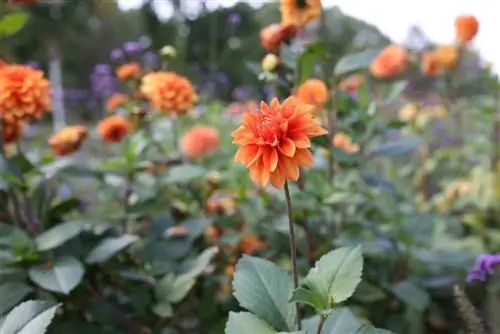
In damp, warm basements, the dahlia's storage organs tend to rot. Mold often forms in affected areas. Since damaged areas are sometimes overlooked when storing, the dahlias should be checked every four weeks. Sort out any tubers that don't look absolutely perfect. If the storage organs appear excessively dry (the skin becomes wrinkled), ensure a slightly higher level of humidity. You can do this by lightly spraying the peat moss, sand or sawdust with water or alternatively placing a bowl of water next to the boxes. However, do not spray the water directly onto the tubers and make sure that no puddles form.
Losses
Despite perfect preparation and storage, it is possible that some dahlia tubers will die or rot. This is completely normal and cannot be prevented. However, with good preparation and control, losses are limited. The stronger and he althier the tubers are, the greater the chance that they will survive the winter unscathed. Weak, thin tubers arise when the following conditions are met:
- they come from very young plants
- the older the dahlia, the larger the tubers become
- they couldn't grow for an entire summer
If the dahlias do not have enough time to grow and store nutrients in the underground organs, they are only sparsely developed. The following year, make sure to plant them early enough and leave them uncut in the bed long enough. The pretty summer bloomers tolerate light frosts well. They only have to be taken out of the ground when the ground threatens to freeze.
Advance
It can happen that the tubers of the dahlia sprout again in their winter quarters. But that is no cause for concern. These shoots are simply shortened before planting out in spring. If you want, you can also plant your dahlias in a targeted manner to give them a head start. Anyone who takes care of their dahlias in early spring will be rewarded with particularly early and lush flowers. Remove the tubers from their winter quarters and make it easier for the plants to start the gardening season. All you need is a flower pot and some substrate.
- Time: from March
- plant in a container filled with substrate
- plant only one plant per pot
- Planting depth: 5 cm
- Location: bright window
- Temperature: 8 to 15 degrees (not too warm)
- water sparingly
If the pre-grown dahlias come into the bed from mid-May, they have a good head start compared to the directly planted flowers and are already significantly more developed. This means they can also better withstand attacks from slugs.
Planting out

Dahlias do not necessarily have to be advanced. The tubers can also be planted directly into the garden soil immediately after winter rest and a final check. The best time is between the end of April and mid-May. It is important that the soil is not too wet. Since the last late frosts have no effect on the beautiful flower, you don't have to wait until the Ice Saints to plant them.
- Time: from the end of April
- do not plant during prolonged periods of rain
- the soil should only be slightly moist
- Planting depth: about 5 cm of soil above the tuber
Conclusion
Since dahlias originally come from sun-drenched Mexico, they are unfortunately not sufficiently frost hardy here. However, your tubers can be overwintered easily and without much effort in any unheated cellar or frost-free garage. Under cool and dry conditions, there is a high chance that the dahlias will survive the winter months unscathed.

